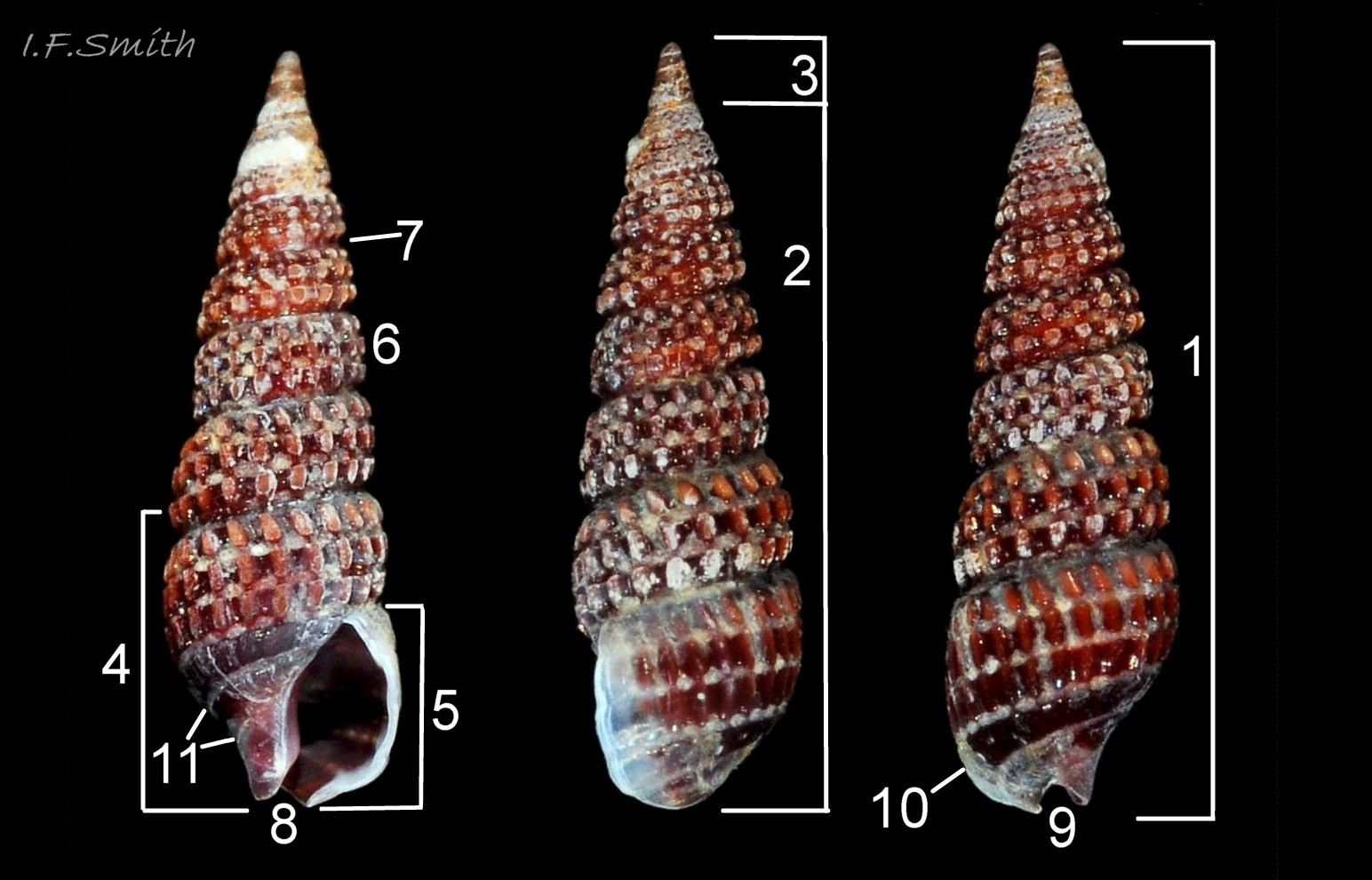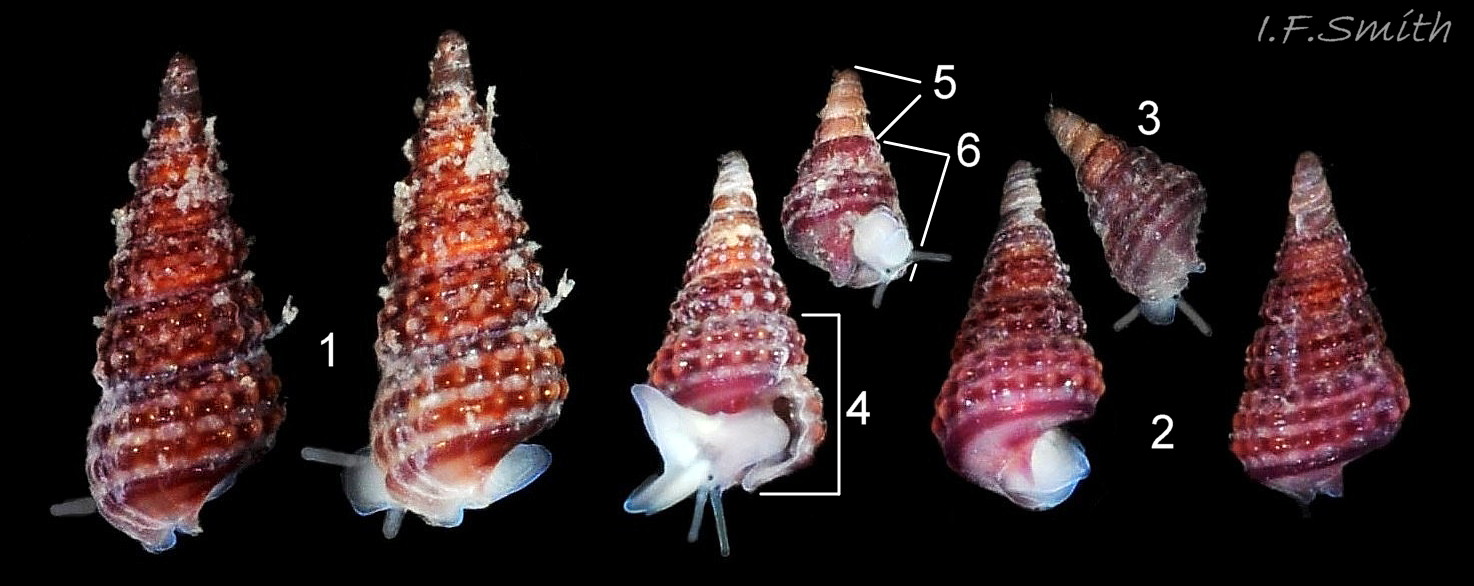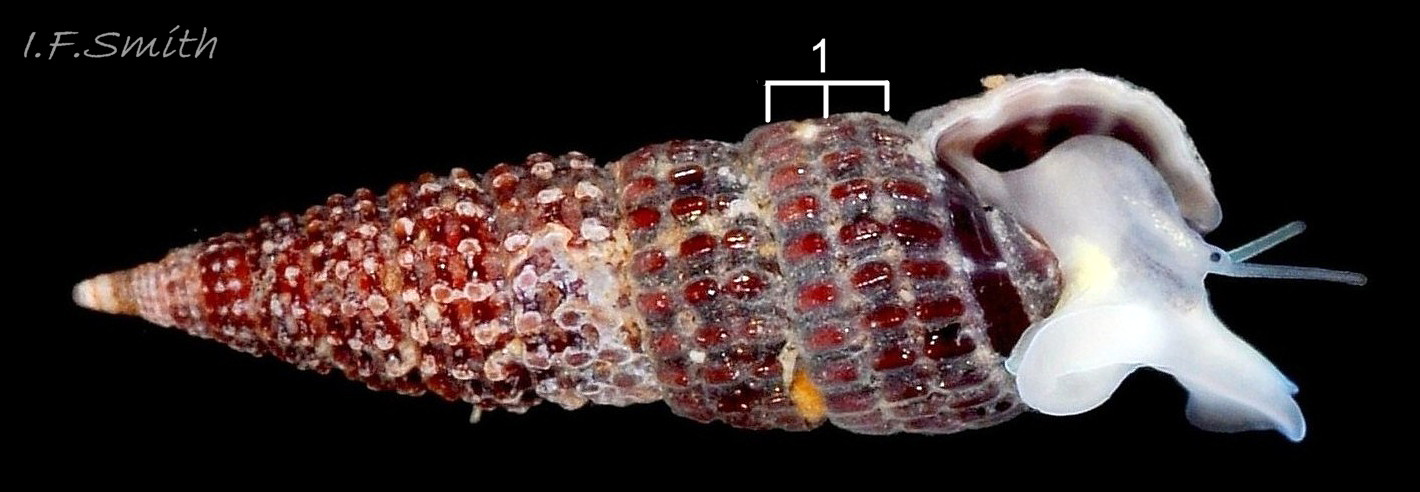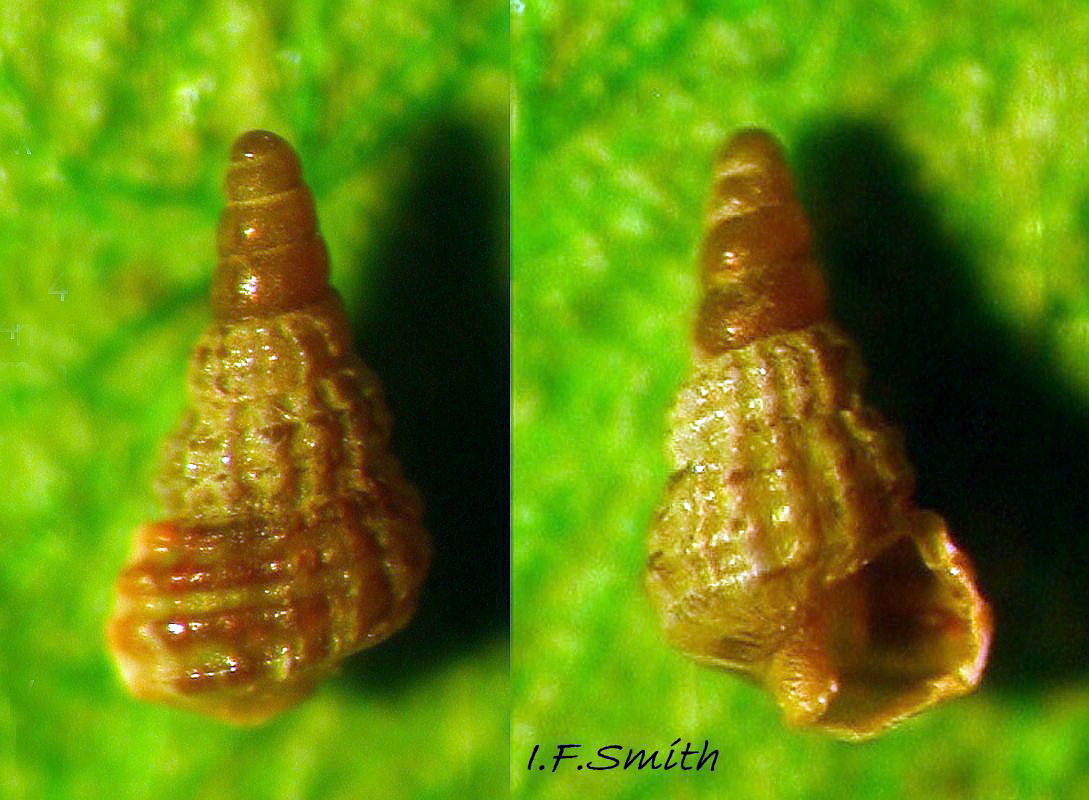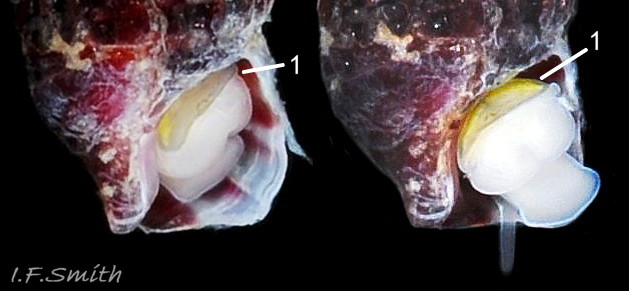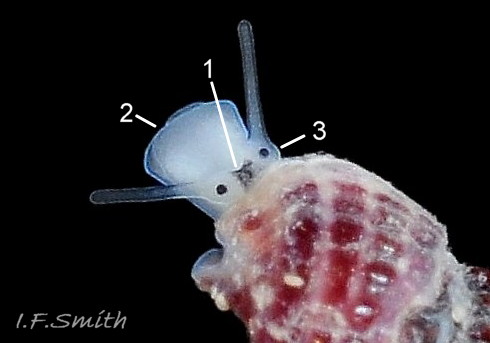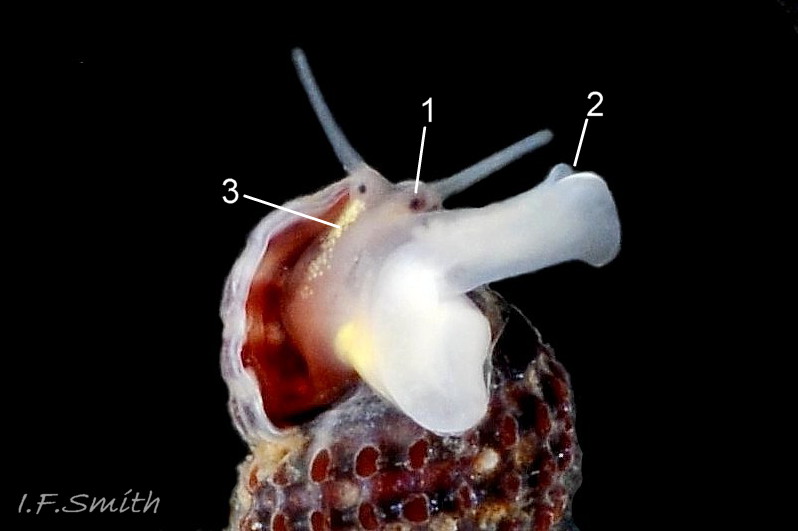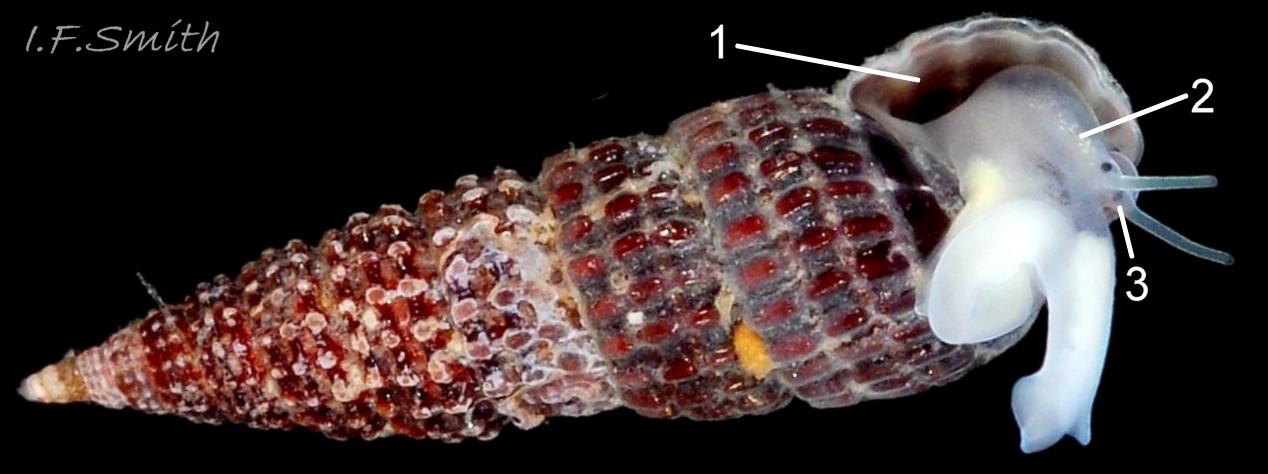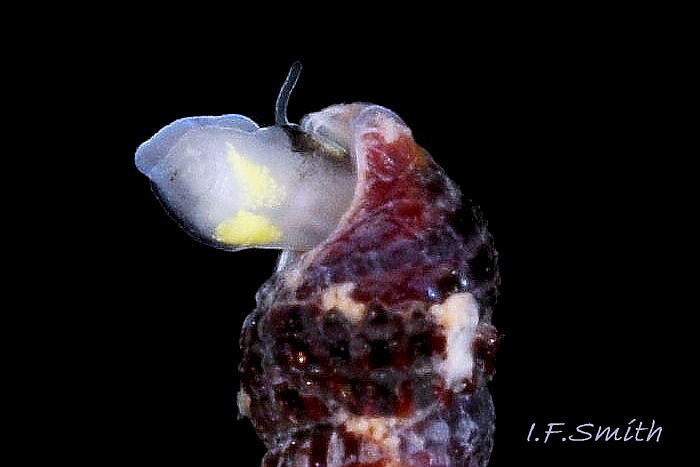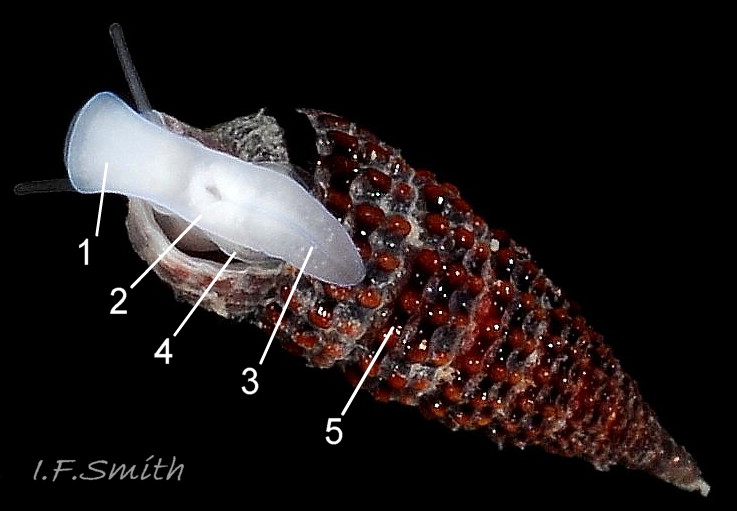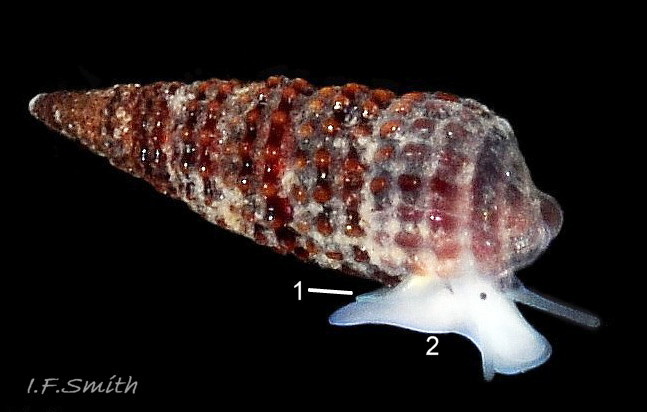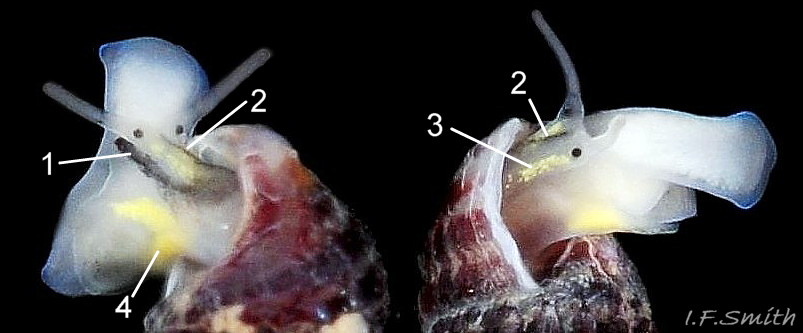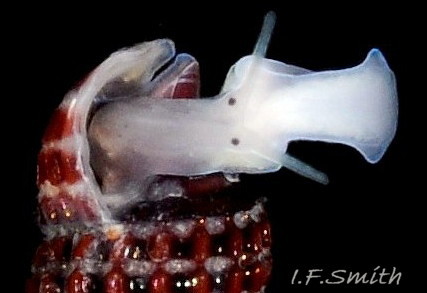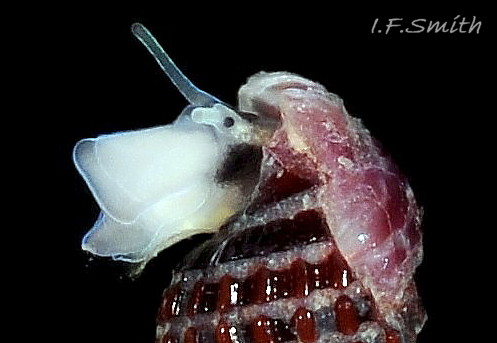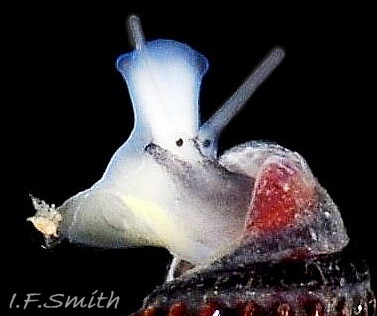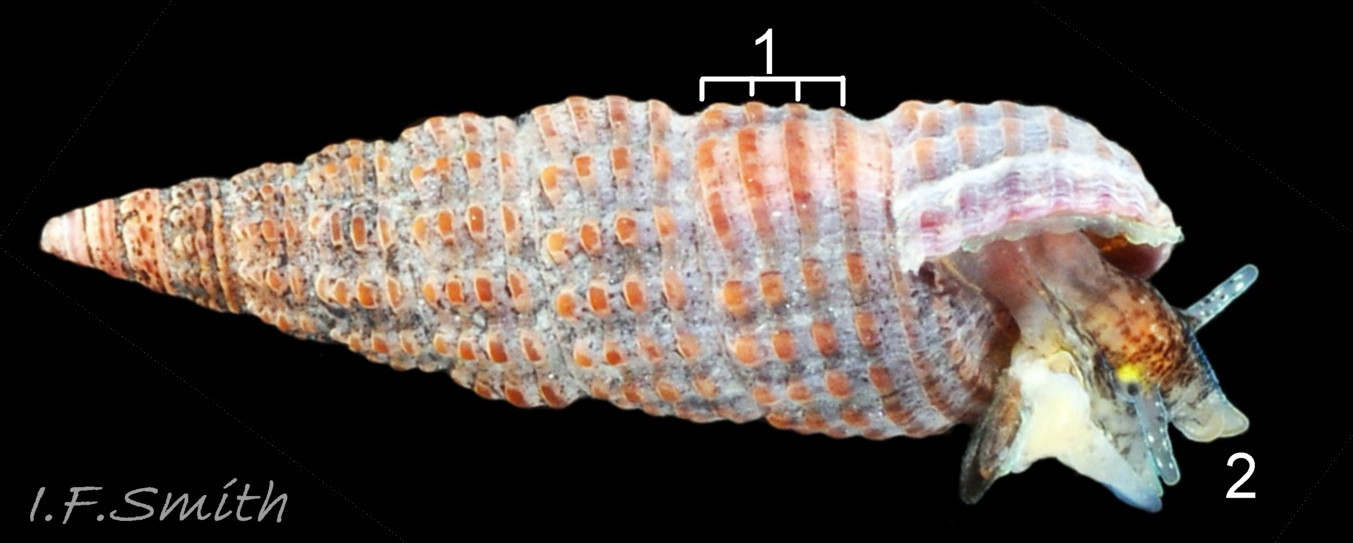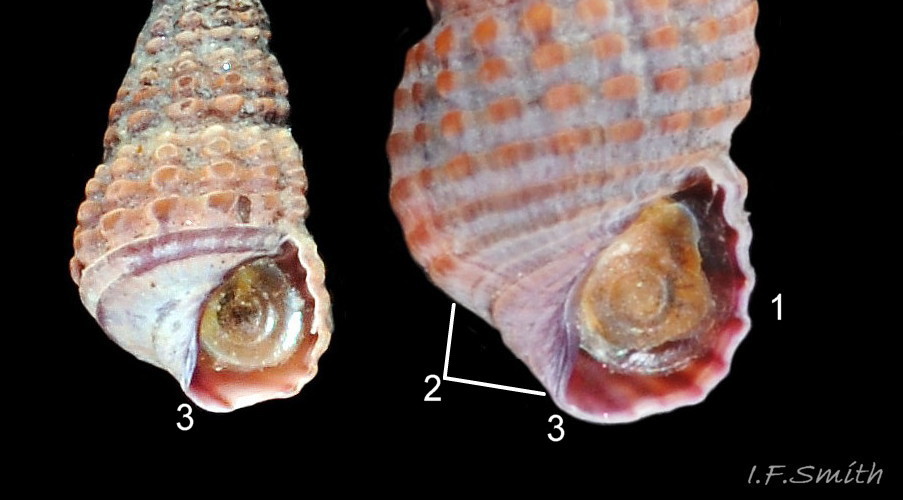Click image to enlarge with full caption
Cerithiopsis tubercularis (Montagu, 1803)
Synonyms: Murex tubercularis Montagu, 1803; Cerithiopsis tuberculare (Montagu, 1803); Cerithiopsis clarki Forbes & Hanley, 1851.
Current taxonomy: World Register of Marine Species (WoRMS)
https://www.marinespecies.org/aphia.php?p=taxdetails&id=139085
Vernacular: Horn shell (English), naaldjebruine, sponshoren (Dutch).
Glossary below
Shell description
C. tubercularis grows up to 6.5 mm high. In profile it is a tall cone with convex sides. It has up to 14 whorls, including the protoconch. The body whorl forms 35-40% of the adult shell height 01 Cerithiopsis tubercularis . Juveniles have a shorter stouter cone; the body whorl is about 50% of the shell height on a 2 mm high shell 02 Cerithiopsis tubercularis . The nearly flat whorls of the teleoconch are glossy maroon to dark brown, and the sutures are in deep furrows. Each whorl of the teleoconch has three spiral rows of rectangular bead-like tubercles which are evenly spaced to give a square lattice appearance 03 Cerithiopsis tubercularis . The base of the body whorl below its periphery has a fourth darker, smooth or very slightly tuberculated, spiral band, and two or three inconspicuous whitish spiral riblets 01 Cerithiopsis tubercularis . The protoconch consists of the four apical whorls which form an elongate brownish apex; its whorls are moderately convex and smooth apart from microscopic granulation below the suture sometimes revealed by a scanning electron microscope. The protoconch, which remains the same absolute size at all growth stages, is largest relative to shell height on juvenile shells being about 34% of the height on a 1.4 mm high shell 04 Cerithiopsis tubercularis . Beached strandline shells often have the protoconch damaged or lost. The small elliptical aperture is 20-25% of adult shell height and about 34% of a 1.4 mm high juvenile. There is a short siphonal canal at the base of the aperture 01 Cerithiopsis tubercularis & 08 Cerithiopsis tubercularis . The palatal (outer) lip has a sharp, scalloped and strongly arched edge 09 Cerithiopsis tubercularis . There is no umbilicus. The small, thin, oval, operculum is an incomplete spiral with an excentric nucleus near the basal edge. It is transparent and shows a pair of yellow marks on the underlying opercular disc 05 Cerithiopsis tubercularis .
Body description
The short, slender, smooth, bluntly tipped cephalic tentacles each have an eye on the thickened base 06 Cerithiopsis tubercularis . There is no snout. Instead there is a small, black, opening 07 Cerithiopsis tubercularis & 09 Cerithiopsis tubercularis ventrally between the bases of the tentacles from which a slender acrembolic proboscis can be protruded. The slender, white respiratory siphon has a bifid tip 08 Cerithiopsis tubercularis and rests in the much wider siphonal canal beyond which it does not protrude. The mantle is translucent whitish or whitish and grey like the body and shows the shell colour through it 09 Cerithiopsis tubercularis . The foot is truncated at the front and tapers to blunt point at the posterior. It is usually extended well beyond the head and can fold across its middle at a transverse groove 09 Cerithiopsis tubercularis . There is a pair of sulphur-yellow marks on the opercular lobe to which the operculum is attached 10 Cerithiopsis tubercularis. There is a large anterior pedal gland in the widely bilaminate, broad, anterior of the foot 07 Cerithiopsis tubercularis . The large circular opening of the pedal gland near the centre of the white sole 11 Cerithiopsis tubercularis , exudes copious mucus which is formed in a long deep medial groove into a support line for climbing among weed. The genital duct in both sexes is an open groove in the mantle cavity; there is no penis on males.
The ground colour of the body is translucent whitish with varying amounts of grey apart from on the pure white foot 12 Cerithiopsis tubercularis . Frequently, there is a longitudinal band of sulphur-yellow 13 Cerithiopsis tubercularis or yellowish-white 09 Cerithiopsis tubercularis opaque spots behind each eye, but it is sometimes absent 14 Cerithiopsis tubercularis . The amount and intensity of grey on the body varies from none 14 Cerithiopsis tubercularis to almost solid black 15 Cerithiopsis tubercularis , and can even vary between left and right on the same animal 13 Cerithiopsis tubercularis . Often, there are three strong, grey, longitudinal bands between and flanking the tentacles 16 Cerithiopsis tubercularis .
Key identification features
Cerithiopsis tubercularis
1) Dextral shell with a tall maroon spire and a short siphonal canal; to 6.5 mm high 01 Cerithiopsis tubercularis . Operculum transparent colourless showing yellow of opercular lobe 05 Cerithiopsis tubercularis .
2) Three spiral rows of tubercles on whorls 03 Cerithiopsis tubercularis .
3) Base of final whorl lacks tubercles and has 2 or 3 spiral ridges 01 Cerithiopsis tubercularis .
4) Lives at LWS and sublittorally.
5) Feeds on Hymeniacidon perleve and Halichondria panicea (sponges). Flesh whitish with varying amounts of grey and a little yellow. No snout.
Similar species
Cerithiopsis barleei Jeffreys, 1867
1) Dextral shell to 7 mm high with a short siphonal canal; paler and more slender than C. tubercularis.
2) Three spiral rows of tubercles on whorls.
3) Base of final whorl lacks tubercles & has no spiral ridges.
4) Lives sublittorally, not on shore.
5) Feeds on Suberites domunculus (sponge). Flesh yellowish. No snout.
Cerithiopsis metaxa (della Chiaje, 1828)
1) Dextral shell to 8 mm high; very tall, slender, almost straight sided, yellowish or whitish with a short siphonal canal.
2) Four spiral ridges, 3 or 4 tuberculated, on penultimate whorl.
3) Base of final whorl lacks tubercles.
4) Lives sublittorally, not on shore.
5) Live animal and habits are little known. Probably no snout.
Bittium reticulatum (da Costa, 1778)
1) Dextral shell to 8 mm high. No siphonal canal but often a basal flared lip on aperture. Operculum brown 18 Cerithiopsis tubercularis .
2) Four spiral rows of tubercles on whorls 17 Cerithiopsis tubercularis .
3) Base of final whorl has several, often weakly defined, spiral ridges with no tubercles18 Cerithiopsis tubercularis .
4) Lives at LWS and sublittorally.
5) Flesh fawn-brown with black and white markings and has well developed snout on head 17 Cerithiopsis tubercularis .
Several other species resemble C. tubercularis, but when the aperture is viewed with the apex uppermost, it is on the left (sinistral shell). They include Marshallora adversa and Monophorus perversus .
Habitat and ecology
C. tubercularis lives on shores at LWS, and sublittorally to about 100 m. It is a specialist feeder on the sponges Hymeniacidon perlevis (Montagu, 1814) and Halichondria panicea (Pallas, 1766). To feed it everts a long fine proboscis and inserts it through a sponge’s osculum. Jaws in the proboscis tip loosen soft tissue which is raked back by the fine, long, claw-like teeth of the radula to the buccal cavity. It favours sponges on rocks with tufts of red seaweed, such as Lomentaria and Corallina. The shell colour matches that of the weed, among which it climbs with the aid of mucus lines excreted from its pedal gland. It also eats debris and epiphytic and epizooic growths on the weed, especially when young.
It breeds in spring and summer. Males lack a penis and release 1 mm long spermatozeugmata into the water to swim in search of a female. Egg capsules, each containing a large number of minute eggs, are inserted into Hymeniacidon perlevis. Veliger larvae emerge to live in the plankton for a lengthy period during which they develop a long protoconch of four whorls 04 Cerithiopsis tubercularis before settling and metamorphosing.
Distribution and status
C. tubercularis occurs from southern Norway to the Azores and eastern Mediterranean, GBIF map https://www.gbif.org/species/2301765 . It is recorded from Ireland and the south, west and north of Britain from Kent to Orkney. It is absent from the north-east Irish Sea and the North Sea coast of Britain between Kent and Orkney. It is occasionally common on the surface of intertidal or sublittoral Hymeniacidon perlevis. U.K. map NBN https://species.nbnatlas.org/species/NBNSYS0000174449 .
References and links
Forbes, E. & Hanley S. 1849-53. A history of the British mollusca and their shells. vol. 3 (1853), London, van Voorst. (As Cerithiopsis tuberculare).
https://archive.org/details/historyofbritish03forbe/page/364/mode/2up .
Plate OO vol.1 https://archive.org/details/historyofbritish01forbe/page/n633/mode/2up
Plate XCI vol.4 https://archive.org/details/historyofbritish04forbe/page/n497/mode/2up
Fretter, V. and Graham, A. 1962. British prosobranch molluscs: their functional anatomy and ecology. London, Ray Society.
Graham, A. 1988. Molluscs: prosobranch and pyramidellid gastropods. Synopses of the British Fauna (New Series) no.2 (Second edition). Leiden, E.J. Brill/Dr. W. Backhuys. pp.662.
Jeffreys, J.G. 1862-69. British conchology. vol. 4 (1867). London, van Voorst. https://archive.org/details/britishconcholog04jeffr/page/264/mode/2up?view=theater &
https://archive.org/details/britishconcholog04jeffr/page/n503/mode/2up?view=theater
Glossary
abapical = away from the apex of the shell.
acrembolic = (of proboscis) introversible/eversible like finger of glove.
adapical = towards the apex of the shell.
aperture = mouth of gastropod shell; outlet for head and foot.
apical = at the apex.
cephalic = (adj.) of or on the head.
dextral shell = in apertural view with spire uppermost, the aperture is on the right.
height = (of gastropod shells) distance from apex of spire to base of aperture.
LWS = low water spring tide, two periods of a few days each month when tide is lowest.
mantle = sheet of tissue which secretes the shell and forms a cavity for the gill.
opercular = (adj.) of the operculum.
opercular disc = part of foot attached to operculum.
opercular lobe = extension of opercular disc round edge of part of operculum.
operculum = plate of horny conchiolin used to close shell aperture.
osculum = large exhalent opening on some sponges.
plankton = animals and plants that drift in pelagic zone (main body of water).
protoconch = apical whorls produced during embryonic and larval stages of gastropod; often different in form from other whorls (teleoconch).
sinistral = aperture is on the left in apertural view with spire uppermost.
siphon = extension of mantle to form a channel for respiratory water current.
siphonal canal = grooved or tubular extension of outer lip of the shell aperture on some snails, to support the siphon.
spermatozeugma = (pl. spermatozeugmata) structure about 1 mm long that swims by undulating anterior plate to take long tail carrying thousands of sperm long distances through sea in search of female. Found in Epitoniidae and Cerithiopsidae where male lacks penis.
sublittoral = below level of low water spring tide.
suture = groove or line where whorls adjoin.
teleoconch = parts of mollusc shell other than the larval-stage protoconch.
veliger = shelled larva of marine gastropod which swims by beating cilia of a velum (bilobed flap).
